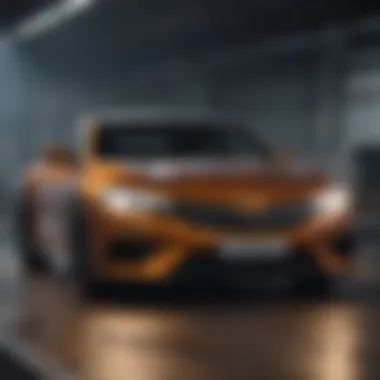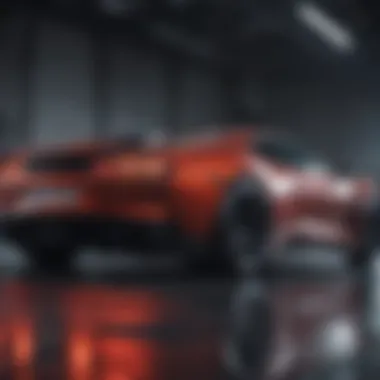High Beams and Automotive Safety: A Comprehensive Guide


Intro
High beam lighting plays a critical role in automotive safety, yet its importance is often overlooked by many drivers. This section provides a fresh perspective on high beams, summarizing their engineering and how they enhance visibility in various driving conditions. Understanding high beam lighting is not just for automotive enthusiasts—new car buyers should also consider it crucial when evaluating vehicles.
When driving at night or in adverse weather conditions, the ability to see further down the road can make a significant difference in avoiding accidents. High beams deliver a powerful light that enhances overall visibility. However, there are regulations regarding their use, as improper usage can lead to glare for oncoming drivers.
This article dissects the multifaceted role of high beams, emphasizing their engineering background, the benefits they provide for safety, and their evolving technologies.
In-Depth Car Reviews
Overview of the Vehicle
When considering the significance of high beams, analyzing specific models reveals how manufacturers integrate lighting technology into overall vehicle design. For instance, the Toyota Camry and Ford F-150 have different high beam systems, each optimized for their respective environments. This section will explore how each vehicle approaches high beam lighting to enhance safety.
Key Specifications
Understanding the specifications of high beams sheds light on their effective use. Key specifications may include:
- Lumens output: Higher lumens equate to brighter light, which significantly boosts visibility.
- Beam pattern: Different patterns affect how the light is distributed. For example, some models utilize adaptive high beam technology that adjusts based on oncoming traffic.
A strong case can be made for models equipped with robust high beam systems, contributing positively to overall safety ratings.
Performance Analysis
High beam performance can be influenced by various factors, including light source type—halogen, LED, or HID. Each has its advantages and limitations. LEDs, for example, typically provide improved longevity and better energy efficiency compared to traditional halogen bulbs. Performance analysis includes:
- Visibility Range: How far light reaches and illuminates the road is crucial for safe driving.
- Reaction Time: Drivers react faster when they can see potential hazards earlier.
Interior and Exterior Design
The design of high beam systems often blends with the vehicle's aesthetics. The Audi A4, known for its sleek design, incorporates high beams that not only excel in performance but also enhance the car’s overall look.
Safety Ratings and Features
High beam technology is factored into safety ratings by organizations like the National Highway Traffic Safety Administration. Vehicles that come with advanced lighting technology often benefit from better safety ratings due to improved visibility and less glare.
Buying Advice
Budget Recommendations
Prospective buyers should consider the investment in vehicles equipped with advanced lighting systems. Evaluating models based on high beam functionalities can prove beneficial in the long term.
Financing Options
Whether through leasing or financing, understanding the costs associated with vehicles having premium lighting can enhance decision-making. Be sure to check if high beam upgrades are included in promotional offers.
Best Time to Buy
Automotive deals often surface during end-of-year sales. Research indicates that dealerships tend to discount models featuring new high beam technologies as they prepare for the next year’s stock.
Resale Value Considerations
High beam functionality can influence a car's resale value as these features become more desirable among buyers.
Comparing Similar Models
When comparing vehicles, focus on high beam technologies. The Honda Accord versus Mazda 6 can showcase different advances in lighting, directly impacting the driving experience.
Technological Trends
Latest Innovation Highlights
In recent years, high beam technologies have seen substantial improvements. Vehicles equipped with adaptive high beams adjust automatically based on surrounding conditions, promising elevated safety.
Impact of Technology on Driving and Safety
The advent of intelligent lighting systems that respond to traffic dynamics signifies the future of driving safety. The adjustment for oncoming traffic minimizes glare, benefiting everyone on the road.
Future Trends and Predictions
Expect to see more integration with autonomous driving systems, where high beam functionalities will be enhanced by AI. This shift could redefine road safety.


How to Choose Technological Features
When buying a car, prioritize models offering advanced lighting technology, as they can provide an edge in terms of visibility and safety.
Case Studies of Cutting-Edge Technology in Current Models
The Mercedes-Benz E-Class utilizes adaptive high beam systems. Their practical application can lead to noteworthy improvements in nighttime driving experiences.
Car Maintenance Tips
Regular Maintenance Schedule
Regular checks of high beam functionality should be part of vehicle maintenance. Ensuring bulbs are intact and properly adjusted will sustain their effectiveness.
DIY Tips and Tricks
Drivers can often change light bulbs with simple tools. Regularly clean lenses can also enhance brightness and clarity.
Common Problems and Solutions
If high beams flicker or do not function, it may indicate electrical issues or a blown bulb. Troubleshooting steps can lead to swift solutions.
Importance of Professional Maintenance
For comprehensive checks, seeking professional maintenance ensures all systems, including lighting, operate optimally.
Seasonal Maintenance Practices
Consider higher beam maintenance during winter months when visibility is often compromised. Preparation for adverse weather can improve driving safety significantly.
Understanding high beams is essential for anyone looking to maximize their automotive safety. Knowledge of how these systems work enhances the ability to choose wisely when purchasing a vehicle. This narrative serves to guide both seasoned enthusiasts and new buyers in appreciating the nuanced role of high beam lighting.
Prelims to High Beam Lighting
High beam lighting plays a crucial role in enhancing vehicle visibility at night or during low-light conditions. Understanding their function is essential for automotive enthusiasts and new car buyers alike. High beams are designed to illuminate a longer range ahead of the vehicle, significantly improving sightlines in dark environments. This capability allows drivers to react promptly to obstacles, road signs, and other vehicles that might otherwise remain hidden in shadow.
Definition and Purpose
High beams are lights that provide a powerful and intense source of illumination directed ahead of the vehicle. Their primary purpose is to enhance visibility in dark situations. Unlike low beams, high beams shine further and wider, allowing drivers to see obstacles from a greater distance. This capability can be vital for long-distance driving where quick reactions are necessary to avoid dangers on the road.
These lights work best when there is no oncoming traffic, minimizing glare that can blind other drivers.
Historical Context
The evolution of high beam lighting is deeply rooted in advancements in automotive technology. Early automobiles used simple oil lamps for illumination. With the development of electrical lighting systems in the early 1900s, headlamps became more powerful and efficient. The introduction of halogen bulbs in the 1960s marked a significant milestone. These bulbs offered longer life and brighter light compared to previous technologies.
As industry regulations evolved, so did the standards for high beam lighting. Today, options like HID and LED have revolutionized visibility perspectives. Understanding this historical development allows consumers to appreciate the modern capabilities of their vehicles.
"High beams are not just a feature; they are a critical component for night driving safety."
In summary, the importance of high beam lighting cannot be understated. Their role in providing better visibility and safety on the road is essential for a positive driving experience.
Technical Aspects of High Beam Lights
The technical aspects of high beam lights are essential for understanding how they function and contribute to automotive safety. This section outlines the various types of high beam lighting, how they operate, as well as the installation and adjustment processes involved. Knowing these details helps both automotive enthusiasts and new car buyers make informed decisions about vehicle lighting options.
Types of High Beam Lighting
Halogen
Halogen lights are a traditional form of high beam lighting. They contain a tungsten filament and halogen gas, which enhances light output. The key characteristic of halogen lights is their cost-effectiveness. They are a popular choice because they provide decent brightness and can be found in many vehicles. However, they have a shorter lifespan compared to other types, and their light output is not as powerful as some modern options.
HID
High-Intensity Discharge (HID) lights are more advanced than halogen lights. They use an electrical arc between two electrodes to produce light. A significant feature of HID lights is their brightness. They emit a more intense light compared to halogen, which enhances visibility significantly during night driving. However, they require a ballast to regulate power, complicating installation. Moreover, their high brightness can cause glare for oncoming drivers, a downside that needs consideration.
LED
Light Emitting Diode (LED) technology is becoming a standard in automotive lighting. LEDs are highly efficient and have a longer lifespan than both halogen and HID lights. A noteworthy characteristic of LED lights is their quick response time, as they light up almost instantly. They produce less heat, which improves durability. Despite their many advantages, higher initial costs and more complex installation can be barriers for some vehicle owners.
Laser
Laser headlights represent cutting-edge technology in automotive lighting. They are known for their precise light focus and exceptional reach. The primary advantage of lasers is their efficiency; they can provide immense light output with minimal energy use. However, the technology is still emerging, leading to higher costs and limited availability in the market.


How High Beams Work
Light Output
The light output of high beams is critical for nighttime visibility. This is measured in lumens, with high-beam lights offering greater lumens than low beams. The advantage here is clear: increased light output translates to better visibility, allowing drivers to perceive their surroundings more effectively during dark conditions. High beams can illuminate far-off objects, which helps in identifying obstacles or hazards.
Beam Patterns
Understanding beam patterns is crucial for effective high beam usage. They can be categorized into different shapes, affecting how light is distributed on the road. A well-designed beam pattern ensures even lighting across the road without leaving dark spots. This feature is important to enhance visibility and minimize glare for other drivers. Poorly designed patterns, however, can lead to dangerous situations, as they may not properly illuminate critical areas of the road.
Electrical Systems
High beams are integrated into a vehicle's electrical system, which plays a vital role in their operation. The electrical systems regulate power flow and ensure that high beams provide optimal performance. A critical point to note is the importance of harnessing electrical compatibility with vehicle components. Too much power can damage lights, while insufficient supply can lead to dim illumination.
Installation and Adjustment
Factory Settings
Factory settings for high beam lights are determined during vehicle production. These settings ensure that lights are properly aligned for optimal performance. The benefit of factory settings is that they provide a reliable baseline, reducing the risk of improper installation. However, wear and tear may necessitate adjustments over time.
Aftermarket Solutions
Aftermarket solutions for high beam lights can provide enhancements or upgrades. These might include brighter bulbs or different technologies. The main advantage of such solutions is customization, allowing drivers to improve illumination to meet their specific needs. However, after-market installations may void warranties and require professional calibration to avoid problems.
Alignment Techniques
Proper alignment of high beams is critical to ensure safety and effectiveness. Several techniques exist for alignment, such as using wall tests or aiming tools. The key reason for proper alignment is to minimize glare for other drivers while maximizing visibility for the driver. Misaligned beams can create dangerous driving conditions, making regular checks advisable.
Driving Conditions and High Beams
Driving conditions significantly influence the effectiveness of high beam lighting. Understanding these conditions can help drivers optimize their use of high beams, enhancing overall safety. High beams allow for greater visibility during low-light situations. However, their deployment must be adjusted based on environmental conditions.
Night Driving Performance
Night driving presents unique challenges that high beams are designed to address. During nighttime hours, visibility decreases to a level where standard headlights may not suffice. High beams provide a broader and more intense light output, illuminating darker areas. This enhancement can help drivers detect obstacles, pedestrians, or animals on the road sooner. Proper usage of high beams can thus increase reaction times, potentially reducing accident rates during night travel.
Inclement Weather Considerations
Weather conditions also affect how effectively high beams perform. In certain situations, high beams may create glare or scatter light in ways that hinder visibility.
Fog
Fog is a specific weather condition that can reduce visibility to very low levels. High beams, in this case, are generally not recommended. The light from high beams can reflect off fog, creating a wall of brightness that obscures rather than enhances visibility. This specific characteristic makes fog an important consideration when discussing high beam usage. Instead, drivers should use low beams to cut through the fog effectively, providing a clearer view of the road.
Rain
Rain presents another challenge for high beams. When it rains, water droplets can scatter light, potentially making it difficult for drivers to see ahead clearly. While high beams can increase illumination, they can also cause intense glare for oncoming vehicles. This glare can distract drivers and create safety risks. Therefore, it is often better to rely on low to medium beam settings during rain. Drivers must balance visibility and glare to ensure safety for themselves and others on the road.
Snow
Snow can complicate visibility as well, but its effects are somewhat different than those of fog or rain. In snowy conditions, high beams can reflect off the snowflakes, creating a dazzling effect that can impair vision. The brightness may also impede depth perception, making it difficult to judge distances. In such conditions, it is advisable to shift to low beams to minimize glare and improve visibility. Understanding how snow interacts with light can help drivers make more informed decisions about their lighting options throughout the winter months.
Country-Specific Regulations
Lastly, high beam usage is often governed by country-specific regulations, which may dictate when and how they can be used. These rules may vary by region and climate, reflecting local driving conditions and cultural norms. Familiarizing oneself with these regulations is paramount to ensuring compliance and enhancing road safety. Regulations may even stipulate the maximum brightness levels for high beams or the required distance at which they can be used without causing glare for oncoming drivers. Being aware of such requirements can prevent misusage and promote safety for all road users.
Safety Implications of High Beam Usage
Understanding the safety implications of high beam usage in automotive lighting is critical. High beams serve as a powerful tool for enhancing visibility on the road, especially in poorly lit areas. However, their effectiveness can also lead to misunderstandings regarding their usage and potential hazards. This section delves into the multifaceted aspects of high beam lighting, focusing on visibility enhancements, the glare effects on others, and statistical analyses surrounding accidents.
Visibility Enhancements
High beams significantly improve a driver’s ability to see further down the road at night. This extended range of visibility allows for earlier detection of obstacles, signage, and other vehicles, which is vital for making informed driving decisions. When conditions are dark, having high-quality high beams can reduce the chances of accidents, enabling drivers to respond more effectively to unexpected situations.
Moreover, the brighter illumination provided by high beams helps in scanning the surroundings. It highlights reflective surfaces and objects that might otherwise blend into the darkness. This enhancement in visibility is particularly beneficial in rural areas where street lighting is scarce.
Key benefits of visibility enhancements include:
- Earlier recognition of potential hazards
- Improved judgment in driving conditions
- Increased confidence when navigating dark roads
Glare Effects on Other Drivers
While high beams are advantageous, they carry the risk of causing glare for oncoming drivers. The intense light can distract and momentarily blind other motorists, creating dangerous situations. This is particularly concerning in situations where high beams are used unnecessarily, such as when there is oncoming traffic or when following closely behind another vehicle.


Drivers must be mindful of timing their usage of high beams, turning them off in situations where glare could affect others. This not only ensures the safety of fellow drivers but also fosters a safer driving environment overall. Legislation often mandates that drivers switch to low beams in the presence of oncoming traffic to mitigate this risk.
"High beams are a useful resource, but with great power comes great responsibility."
Accident Statistics and Analysis
Research into accident statistics highlights the role of high beam lighting in reducing nighttime collisions. According to various studies, visibility is a significant factor in nighttime accidents. Areas with poor lighting suffer higher rates of incidents due to limited visibility.
Some specific findings from statistical analyses include:
- A notable decrease in accident rates when drivers utilize high beams appropriately in dark conditions.
- The correlation between glare-induced distraction and an increase in near-misses or collisions.
- Recommendations for using high beams in accordance with federal and local guidelines to optimize safety.
Understanding these statistics empowers drivers with knowledge about safe high beam usage, ensuring both their safety and that of others on the roadway.
Technological Advances in Lighting
The advancement in lighting technology has significantly transformed automotive safety and efficiency. High beam lighting is an essential aspect of vehicle illumination, serving not only to enhance visibility but also to improve overall driving experience. As technology evolves, so does high beam lighting, with methods that adapt to diverse driving conditions and enhance safety measures. These innovations are crucial for improving night visibility, reducing glare for other drivers, and increasing the anticipation of potential hazards.
Adaptive Headlights
Adaptive headlights represent a leap in automotive lighting technology. They adjust the direction and intensity of light based on the vehicle's speed and steering input. This means when a car turns, the headlights follow the curve of the road, providing better illumination of the path ahead. This technology leads to significantly enhanced vision and safety when navigating through winding roads or sharp turns. The main advantage is that it increases the driver's field of view, allowing for quicker reactions to obstacles. Moreover, these headlights can minimize glare towards oncoming traffic.
Matrix Lighting Systems
Matrix lighting systems take adaptability a step further. These systems use multiple light sources that can be individually controlled. This allows for precise adjustments, enabling certain sections of the light beam to turn off when oncoming vehicles are detected. Therefore, drivers can use their high beams without blinding others. This not only enhances visibility for the driver but also makes the roads safer for everyone. One significant characteristic is the ability to provide a balance between high visibility and respect for others on the road. However, this technology is generally more expensive and may require specialized setups.
Future Innovations
Integration with AI
The integration of artificial intelligence in automotive lighting is an emerging field with substantial potential. AI can help in analyzing surrounding conditions in real time. This includes detecting pedestrians, cyclists, or animals on the road and adjusting the lights accordingly. The key characteristic of this integration is its ability to make instant decisions to optimize lighting based on various factors. It significantly enhances safety, especially in urban areas where dynamic conditions are common. The unique feature of AI integration lies in its data processing capabilities, allowing for continual updates and improvements in lighting patterns. The advantages include heightened safety and possibly increased energy efficiency. Still, it raises concerns about reliability and potential system errors.
Smart Lighting Solutions
Smart lighting solutions encompass various technologies that enhance the functionality and efficiency of vehicle lighting. These systems can interact with other vehicle systems or infrastructure to provide optimal illumination. A key characteristic of smart lighting is its connectivity, enabling features such as automatic switching between high and low beams without driver intervention. This autonomously responsive nature makes it a popular choice for modern vehicles. The unique feature of smart lighting solutions is their capability to learn from driving habits and environments, allowing for adjustments that may improve personal comfort and safety. However, a disadvantage includes the reliance on technology that may be subject to failures or software issues.
Best Practices for High Beam Usage
High beam lights are crucial for enhancing visibility during low-light conditions. However, improper use can lead to increased risk for drivers and others on the road. Understanding best practices related to high beam usage is essential for every driver. Appropriate application of high beams improves safety for both the user and fellow road users. This section outlines best practices to optimize high beam effectiveness while minimizing potential hazards.
When to Use High Beams
High beams should be utilized in specific conditions to maximize their benefits. These are often low-light scenarios, such as:
- Dark rural roads with minimal street lighting.
- Clear conditions where visibility is a concern, free from oncoming vehicles.
- Situations where no other cars are present, allowing for unobstructed view.
Important Note: Always switch to low beams when approaching or following other vehicles to avoid dazzling other drivers.
Common Mistakes to Avoid
Several errors can undermine the effectiveness of high beams and impact safety. These include:
- Failing to switch to low beams when other vehicles are approaching.
- Using high beams in fog, heavy rain, or snow, which can create glare.
- Ignoring state or country regulations regarding high beam usage.
- Not adjusting headlight aim post-installation or after changing light bulbs.
Avoid these mistakes to enhance driving safety and maintain compliance with traffic laws.
Maintenance Tips for Longevity
Proper maintenance of high beam lighting ensures they function effectively. Consider the following:
- Regularly check the alignment of headlights to ensure they provide optimal illumination.
- Clean lenses to remove dirt, grime, or cloudiness that may impair light output.
- Replace bulbs promptly when they begin to dim or burn out. High-quality bulbs like the Philips X-treme Ultinon can improve performance.
- Inspect wiring and electrical connections during routine vehicle maintenance to prevent failures.
Incorporating these practices can extend the life of your high beams and ensure they remain effective throughout the duration of your vehicle's life.
"Usage of high beams should prioritize safety and legal standards. Proper implementation can prevent accidents."
By embracing these best practices for high beam usage, drivers will not only benefit themselves but also contribute to safer roadways for all.
Ending and Future Perspectives
High beam lighting plays a critical role in automotive safety, offering enhanced visibility and awareness during night driving. The effective use of high beams not only improves the driver's line of sight but also significantly contributes to overall road safety. As we look ahead, understanding the advancements in high beam technology and its implications for future automotive design becomes essential. The discussion surrounding this topic is particularly relevant for automotive enthusiasts and new car buyers who seek to maximize their driving experience while ensuring safety.
Summary of Key Insights
This article has highlighted several key points regarding high beam lighting. First, the different types of high beam technologies, such as halogen, HID, LED, and laser lights, are critical to understanding their efficiency and application. Second, we delved into various driving conditions, emphasizing how high beams should be utilized effectively in different environments, including inclement weather. Furthermore, the potential dangers of glare on other drivers were examined, as this can lead to dangerous situations on the road. The statistical analysis presented illustrated the significant impact that proper high beam usage can have on reducing night-time accidents.
The Evolving Landscape of Automotive Lighting
The automotive lighting sector is rapidly evolving with the advent of new technologies. The integration of adaptive headlights and matrix lighting systems signifies a shift towards smarter lighting solutions that adjust to driver needs. Adaptive systems can automatically adjust beam patterns, providing optimum visibility without causing glare to oncoming vehicles. Looking to the future, the potential for AI integration and smart lighting solutions offers intriguing possibilities. With ongoing research and development, we can foresee high beam lighting becoming even more sophisticated, enhancing safety while accommodating various driving conditions.



